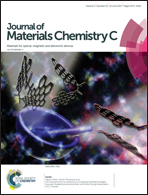Water detection through Nd3+-sensitized photon upconversion in core–shell nanoarchitecture†
Abstract
Herein, a strategy to achieve an 808 nm excitable water probe based on an Nd3+-sensitized core–shell upconversion nanoarchitecture is presented. Specifically, the as-synthesized Yb/Er:NaGdF4@Yb/Nd:NaYF4 active-core@active-shell nanocrystals significantly enhance the Er3+ blue, green and red upconversion emissions with the assistance of spatially confined separation between the Nd3+ sensitizers and Er3+ activators and efficient energy transfer/migration of Nd3+ → Yb3+(shell) → Yb3+(core) → Er3+. To understand the exact mechanisms for water detection, core, core–shell and core–shell–shell samples were prepared and their related water-content dependent upconversion emission and decay behaviors under 980 nm and 808 nm laser excitation systematically investigated. Different to the case of the Yb/Er:NaGdF4 core, the Nd3+-sensitized core–shell product can efficiently avoid excitation attenuation (i.e., absorption of the incident laser) and show two-separated linearity with the logarithm of H2O content at a low water content and high water content intervals, respectively, owing to the combined role of Yb3+ excited state quenching and Er3+ excited state quenching. It is expected that this study could provide insights into the design of upconversion nanoparticle based water sensors.



 Please wait while we load your content...
Please wait while we load your content...